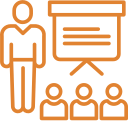What is the Change Curve?
The change curve is a simple framework to help track the progression of individuals, teams, and organizations through change. Across different industries, cultures, and personality types, people go through four very consistent phases of change. Much like people experience a few consistent stages of grief, there are some clearly consistent phases of change.
1. First, we’re all usually in denial. In the first phase, people are either just waking up or have recently awakened to the realization that something needs to be different. If this comes from outside your own initiation, there is a greater tendency to stay in denial. Examples include a major change in the marketplace that undercuts a strategy or a demand by a boss you don’t agree with. It’s easier to not pay attention to these than to deny them. If, however, the desire to change comes from an internal motivation to improve a frustrating state or comes from customer input that you agree with, then denial moves through more quickly to the second phase.
2. The second phase is the time in the change process when it goes from being an “IT” to a “ME.” What I mean is that people experience the loss and disruption of their long-held patterns in this phase. People “resist” in this phase. They’ve moved past denial, but now they’re wrestling with the fact that they have to let go of something.
3. In the third phase, people, teams, or organizations begin to see the future. The frustration or fear of a change has been dealt with to a significant degree, and there is a glimpse of something better, a sense that the change could be good. This is not a uniform experience, and people have this moment at different times, but on the whole, the group enters an exploring phase where they are eager to DO something that leads them forward.
4. This is the culmination. In the fourth phase, people return to a steady state and commit to it. The change has been integrated, and a new pattern emerges. This happens best and most thoroughly when there has been a sense of acknowledging the past and consolidating the group’s commitment and shared understanding of the new pattern.
This model was very helpful in a recent client engagement of mine. A brand new leader had just joined a very large technology services company. This particular team had actually experienced a change in leadership every few months for a few years. They had had 6-10 managers in less than 3 years. The current new leader had been there for about 7 weeks and had projects requiring team cohesion for quick action. I used the change curve to help her fashion an interactive workshop session that allowed her to bring a sense of renewal, connection, and clarity to the team.
Three subgroups of internal culture
The first part of the session consisted of acknowledging just how much change had gone on. By discussing, remembering, and acknowledging the past, people were able to come out of the first denying phase. Something does need to be different now. Then we broke the group up into 3 subgroups dubbed by internal culture as “Old-olds,” “New-olds,” and “Brand-news.”
- “Old-Olds”: Had been at the company for a long time and also in that particular division for a long time. These were the veterans.
- “New-olds”: Had worked at the company for a long time but were new to this group.
- “Brand-news”: These were recent hires, new to both the company and the group.
Subgroups interactions
We helped these three groups talk with each other about what they knew, their perspectives, what had changed, and what had stayed the same. The old-olds could share the history, the new-olds could bridge the gap to other divisions and overall company culture, and brand news could ask questions and offer fresh perspectives. This conversation allowed them to bridge into exploring about what they actually wanted to keep, drop, and create going forward with this division. It allowed them to acknowledge their different histories and emerge as a more unified team. We then ended the session with a time to acknowledge how far the group had come just that day and identified specific actions the group could take in the future to continue their process of renewal. We built resilience.
How it all relates to the Change Curve
You’ll notice that the design and facilitation of this session connected directly to the change curve model. We moved through all 4 phases:
- Denial phase: We acknowledged the amount of change. Waking up to reality helps people move out of denying it.
- Resisting phase: Listening then helps people move through resisting. By grieving, being heard, and hearing others, people are able to stop resisting.
- Exploring phase: Discussing new priorities and goals allowed the team to connect.
- New reality: Acknowledging and consolidating the day’s work allowed the team to confidently move forward with renewed purpose and cohesion. This is what good leaders do to help navigate and set a new beginning.
If you have a major change, you are experiencing or that you are leading, take the time to identify which phase of the change curve you and your team are in at the moment. How might you move to the next phase?
The Change Curve
Where change is the only constant, the change curve serves as a valuable tool for leaders and teams alike. By recognizing and understanding the phases of denial, resistance, exploration, and integration, individuals and organizations can navigate change with greater resilience and clarity. Whether you’re a leader guiding your team through a transition or an individual facing personal change, remember that the change curve is not just a model but a practical guide for embracing transformation with confidence and purpose. By acknowledging where you are on the curve and intentionally moving forward, you can thrive in the face of change and emerge stronger on the other side.
This article was reprinted with permission from the author.



















